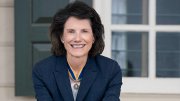 |
| Peter G. Rowe |
| Courtesy of the Harvard Graduate School of Design |
Under Rowe's leadership, the number of senior faculty has more than doubled and the faculty as a whole has increased by 40 percent. At the same time, Rowe told this magazine, the student body has grown only about 15 percent, so the student-faculty ratio, which "wasn't bad before," is now "much better than it was." Advanced-degree programs have doubled in size and broadened in scope during Rowe's 12-year tenure, a professional program in urban planning has been added, and "both the professional and international scope of the school's academic activities" have been "broadened and enlarged significantly." Three research centers have been established or reorganized from other units: the Center for Urban Development Studies; the Center for Design Informatics; and the Center for Technology and the Environment. Most recently, the school has become home to a new interfaculty initiative in real estate and urban development that has been designed to promote research in these and related subjects across the University.
Rowe says that the school operates well at its present size, with approximately 500 students, 60 full-time-equivalent faculty, and 100 staff. "We are pretty productive as a unit," he explains, "and fit well with the physical facilities of the school and the program needs as we understand them now."
There are, nevertheless, several areas where the school could expand its academic offerings if it wished to under a new dean, Rowe points out. The first of these is in the area of design, technology, and new materials: "use of smart materials, microenvironmental control, the interaction between building processes and computer-aided design, and roboticsall recent technological accoutrements of building." This entails "looking at things more microscopically than before." GSD, he notes, already has a very good technology faculty with interests that gravitate to these areas. At the other end of the scale of possibilities for future study is the phenomenon of regionalization, beyond the scope of cities and metropolitan areas. This trend is seen particularly in East Asia, an area that is very familiar to Rowe, an Australian who studies how Western cultural concepts of modernity are being extended and transformed in rapidly urbanizing parts of that region.
Both these areasthe one narrower and the other wider in focus than is traditional for schools of architecture, planning, and landscape architecturecould become tracks within existing degree programs, Rowe suggests. If they became full-blown programs, however, or if other programs were developed and added to the 10 now offered, that would enlarge the student body, possibly increase the size of the faculty, and create a need for more space. Because GSD is "somewhat tight on space now," he says, "the costs associated with pushing the school up in scale are fairly substantialit would mean new buildings, in addition to human resources."
President Lawrence H. Summers praised Rowe for "recruiting extraordinary scholars and practitioners, focusing on significant new areas of research, and improving [the school's] facilities. ....[M]ultidisciplinary centers of study and training like the Harvard Design School," he said, "have a tremendously important role to play, both in pushing the boundaries of the art and science of design and in reflecting critically on the state of our built environment." Summers will appoint a faculty advisory group to assist him in seeking a new dean.





